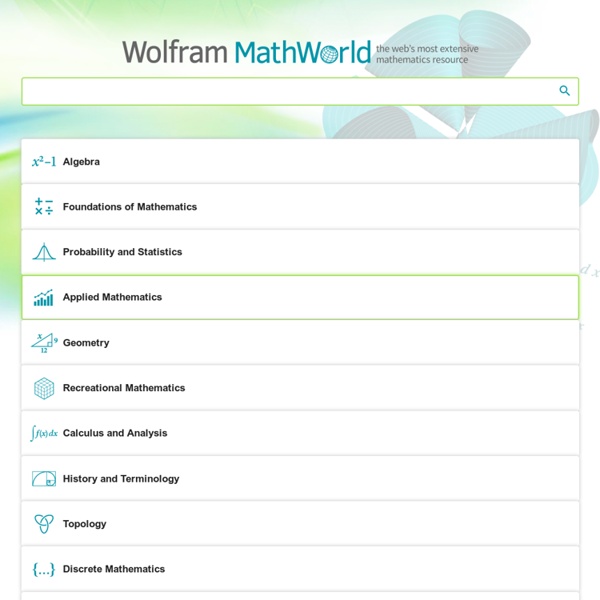



6174 (number) 6174 is known as Kaprekar's constant[1][2][3] after the Indian mathematician D. R. Kaprekar. This number is notable for the following property: Take any four-digit number, using at least two different digits. 9990 – 0999 = 8991 (rather than 999 – 999 = 0) 9831 reaches 6174 after 7 iterations: 8820 – 0288 = 8532 (rather than 882 – 288 = 594) 8774, 8477, 8747, 7748, 7487, 7847, 7784, 4877, 4787, and 4778 reach 6174 after 4 iterations: Note that in each iteration of Kaprekar's routine, the two numbers being subtracted one from the other have the same digit sum and hence the same remainder modulo 9. Sequence of Kaprekar transformations ending in 6174 Sequence of three digit Kaprekar transformations ending in 495 Kaprekar number Bowley, Rover. "6174 is Kaprekar's Constant".
Langtons Ant -- from Wolfram MathWorld - StumbleUpon A 4-state two-dimensional Turing machine invented in the 1980s. The ant starts out on a grid containing black and white cells, and then follows the following set of rules. 1. If the ant is on a black square, it turns right and moves forward one unit. 2. 3. When the ant is started on an empty grid, it eventually builds a "highway" that is a series of 104 steps that repeat indefinitely, each time displacing the ant two pixels vertically and horizontally. (right figure) steps.
How to Become an Early Riser It is well to be up before daybreak, for such habits contribute to health, wealth, and wisdom. – Aristotle Are morning people born or made? In my case it was definitely made. In my early 20s, I rarely went to bed before midnight, and I’d almost always sleep in late. I usually didn’t start hitting my stride each day until late afternoon. But after a while I couldn’t ignore the high correlation between success and rising early, even in my own life. … and the next morning, I got up just before noon. Hmmm… I tried again many more times, each time not getting very far with it. It’s hard to become an early riser using the wrong strategy. The most common wrong strategy is this: You assume that if you’re going to get up earlier, you’d better go to bed earlier. It seems there are two main schools of thought about sleep patterns. The second school says you should listen to your body’s needs and go to bed when you’re tired and get up when you naturally wake up.
- StumbleUpon [ wu :: riddles(hard) ] - StumbleUpon There are three puzzlers in the puzzle forum: A Newbie, a Senior Riddler, and an Uberpuzzler. All three are honest, but can only give answers to the best of their knowledge. Newbies are confused creatures. Until their fifteenth posts, they are only able to make random responses!* Senior Riddlers have great powers of perception, but are not yet infallible. Uberpuzzlers are omniscient beings who are your greatest allies in the Puzzle Forum!!! The Uberpuzzler can exert Influence arbitrarily often. Furthermore, an Uberpuzzler only uses his power of Influence in a very specific way. (Thus, he employs a strategy defined as a mapping f : S3 x {(T|F)*} -> {0,1}, which can be interpreted as follows: for each ordering of the puzzlers "sigma" (a permutation in S3, e.g. Note that this is different from saying that the puzzler chooses when the Uberpuzzler applies Influence! Determine with proof the minimum number of questions which will allow you to identify which puzzler is which.
How to Become a Pure Mathematician (or Statistician) Nuremberg Laws Title page of RGB I No. 100 proclaiming the laws. Issued 16.09.1935. The Nuremberg Laws (German: Nürnberger Gesetze) of 1935 were antisemitic laws in Nazi Germany introduced at the annual Nuremberg Rally of the Nazi Party. After the takeover of power in 1933 by Hitler, Nazism became an official ideology incorporating anti-Semitism as a form of scientific racism. There was a rapid growth in German legislation directed at Jews and other groups, such as the Law for the Restoration of the Professional Civil Service which banned "non-Aryans" and political opponents of the Nazis, from the civil service. The lack of a clear legal method of defining who was Jewish had, however, allowed some Jews to escape some forms of discrimination aimed at them. The Nuremberg Laws classified people with four German grandparents as "German or kindred blood", while people were classified as Jews if they descended from three or four Jewish grandparents. Background history[edit] Toward the Nuremberg Laws[edit] Dr.
Sage and Graph Theory | High School Math and Chess I've already mentioned the beautiful work on graph theory here but I haven't mentioned Sage can help us produce graphs like that, too. You'll need to make sure you've got a copy of the style files (tkz-berge.sty and tkz-graph.sty) in the directory you're working in, though. Sage gives you some predefined graphs to make creating graphs easier. This page has a lot of important information and I used it to create the graph shown on the Problems page. The graph has almost all its edges, so start by creating the complete graph on 5 vertices. from sage.graphs.graph_latex import check_tkz_graph check_tkz_graph() # random - depends on TeX installation g = graphs.CompleteGraph(5) opts = g.latex_options() g.set_latex_options(tkz_style = 'Art') print opts.tkz_picture() The 'Art' style is responsible for making the graphs like at the Altermundus site. code for a Remove an edge from the code by putting a % at the beginning of the line (which comments out the line). file.